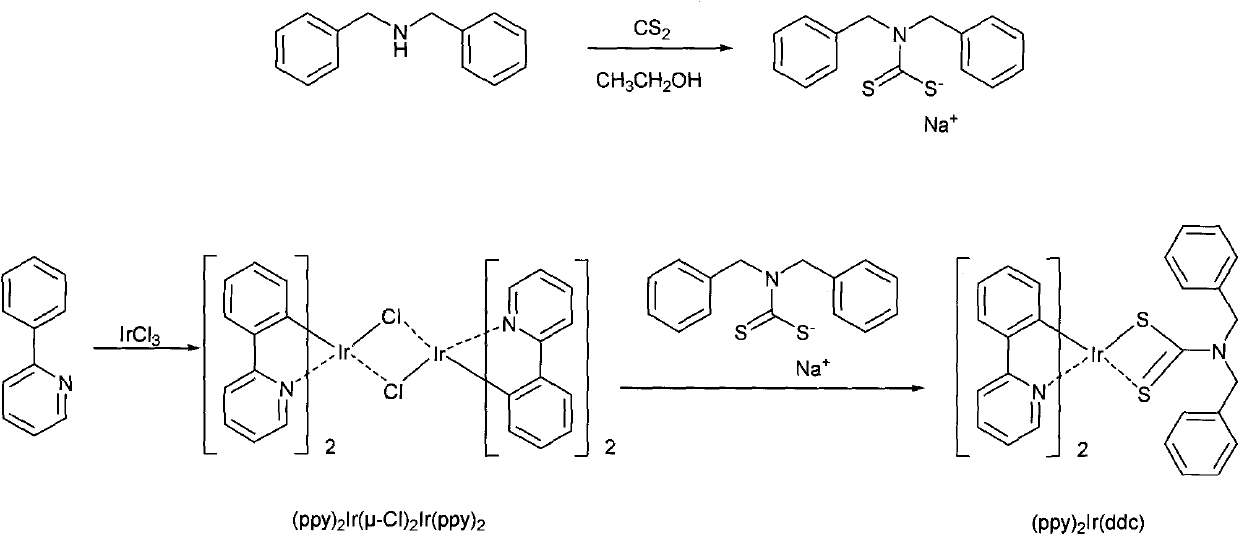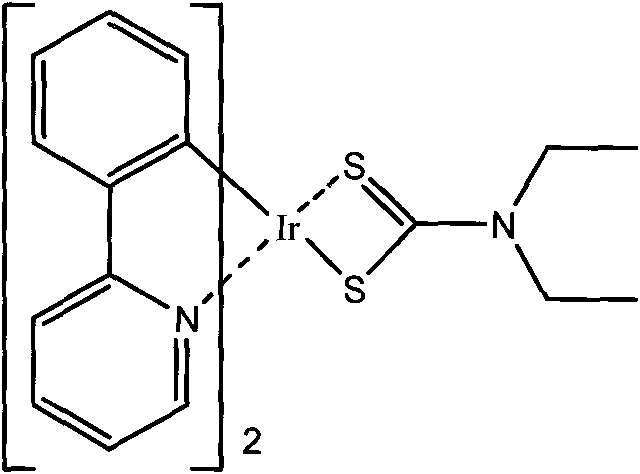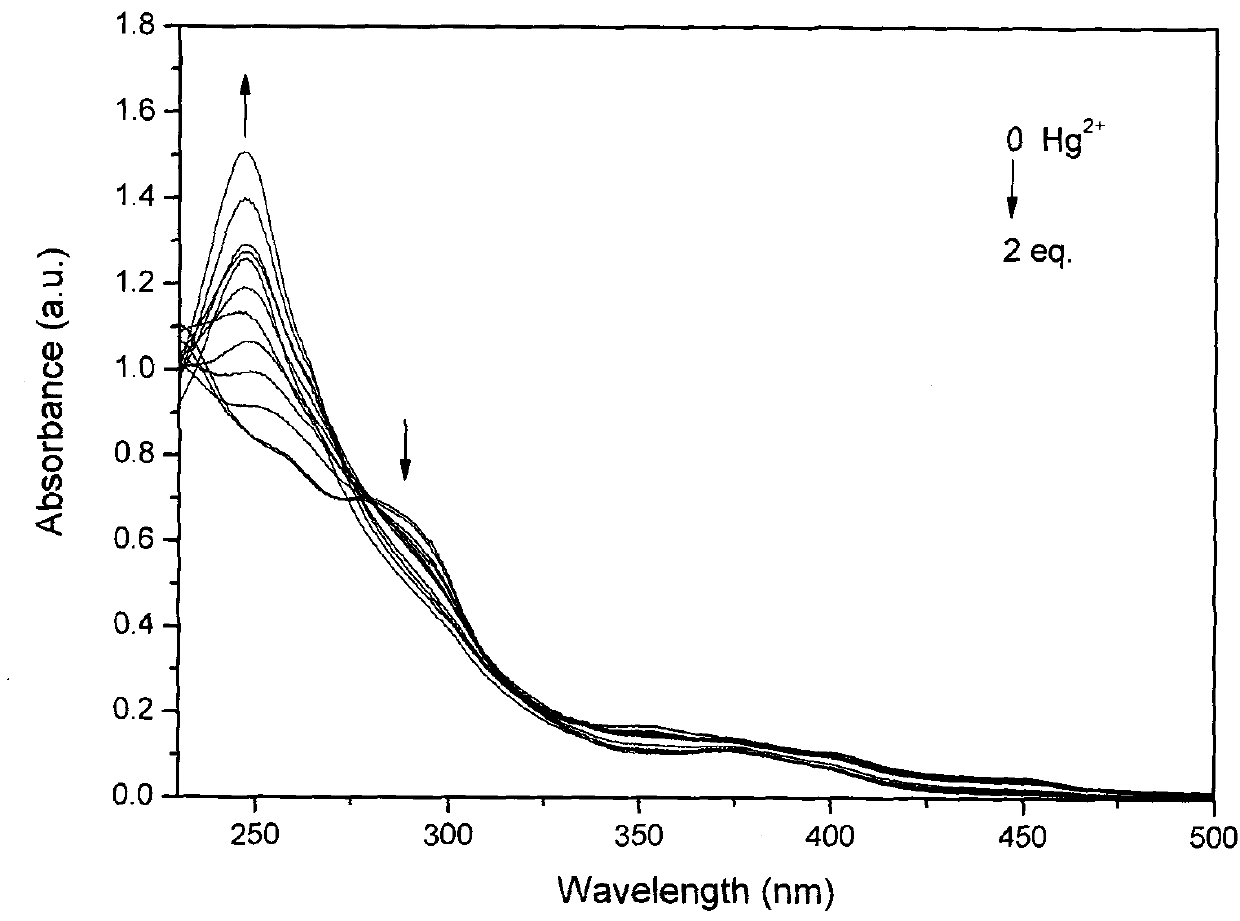Phosphorescence chemical sensor and application thereof
A photochemical sensor and chemical sensor technology, applied in phosphorescent chemical sensors and their application fields, can solve the problems of interference, low sensitivity, complex synthesis, etc., and achieve the effects of good solubility and high detection sensitivity
- Summary
- Abstract
- Description
- Claims
- Application Information
AI Technical Summary
Problems solved by technology
Method used
Image
Examples
Embodiment 1
[0029] Iridium complex (ppy) 2 The synthetic method of Ir(ddc) is as figure 1 Shown:
[0030] At 4°C, carbon disulfide (3.1 mL, 0.052 mol) and 50 wt% aqueous sodium hydroxide solution (4 mL) were slowly added to an ethanol solution of dibenzylamine (9.9 g, 0.05 mol). After stirring for 5 hours, cooling and removal of volatiles, and then recrystallization from ethanol gave sodium dibenzyldithiocarbamate.
[0031] Weigh IrCl 3 ·3H 2 O (0.2g, 0.567mmol) and 2-phenylpyridine (0.22g, 1.42mmol) were added to the double-necked flask, vacuum-filled with nitrogen-vacuumized on the double-row tube, cycled three times, and finally protected the reaction with nitrogen system. After injecting 15 mL of a mixture of 2-ethoxyethanol and water (3:1, v / v) with a syringe, the reaction mixture was heated to 100° C., and the reaction was stirred for about 20 hours. After the reaction was stopped, the reaction mixture was cooled to room temperature, and a precipitate was obtained by filtratio...
Embodiment 2
[0033] Embodiment 2 iridium complex (ppy) 2 Preparation of Ir(ssc)
[0034] Weigh IrCl 3 ·3H 2 O (0.2g, 0.567mmol) and 2-phenylpyridine (0.22g, 1.42mmol) were added to the double-necked flask, vacuum-filled with nitrogen-vacuumized on the double-row tube, cycled three times, and finally protected the reaction with nitrogen system. After injecting 15 ml of a mixture of 2-ethoxyethanol and water (3:1, v / v) with a syringe, the reaction mixture was heated to 100° C. and stirred for about 20 hours. After the reaction was stopped, the reaction mixture was cooled to room temperature, and a precipitate was obtained by filtration. The resulting precipitate was washed with water and ethanol respectively to obtain a yellow solid iridium dichloro bridge compound (ppy) 2 Ir(μ-Cl) 2 Ir(ppy) 2 .
[0035] Add the iridium dichloro bridge compound, the auxiliary ligand diethyldithiocarbamate sodium salt (0.29g, 1.7mmol) and 24mL 2-ethoxyethanol into the double-necked flask, vacuum-fill ...
Embodiment 3
[0037] Based on iridium complexes (ppy) 2 Ir (ssc) phosphorescence chemical sensor response to mercury ion UV-visible absorption spectrum test such as image 3 shown, with Hg 2+ (0~4.0×10 -5 mol / L), (ppy) 2 Irsc acetonitrile solution (2.0×10 -5 mol / L) UV-Vis absorption spectrum changes significantly. The absorption peak at 290nm becomes weaker gradually, while the absorption peak at 250nm becomes stronger.
PUM
 Login to View More
Login to View More Abstract
Description
Claims
Application Information
 Login to View More
Login to View More - R&D
- Intellectual Property
- Life Sciences
- Materials
- Tech Scout
- Unparalleled Data Quality
- Higher Quality Content
- 60% Fewer Hallucinations
Browse by: Latest US Patents, China's latest patents, Technical Efficacy Thesaurus, Application Domain, Technology Topic, Popular Technical Reports.
© 2025 PatSnap. All rights reserved.Legal|Privacy policy|Modern Slavery Act Transparency Statement|Sitemap|About US| Contact US: help@patsnap.com



